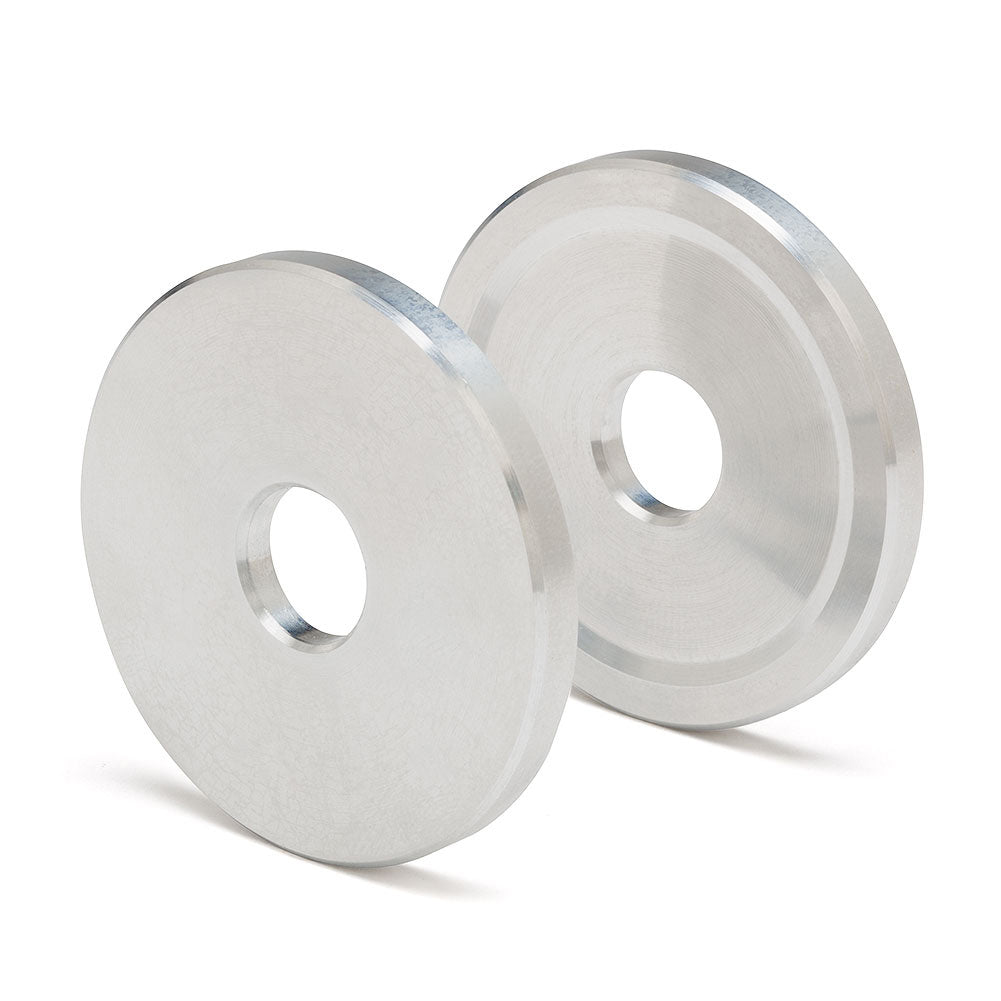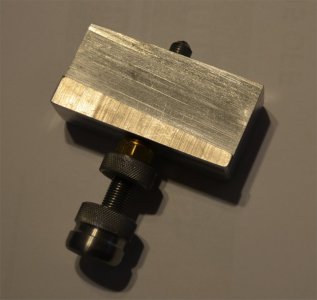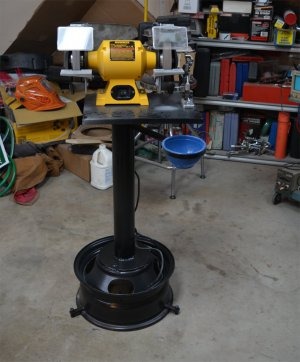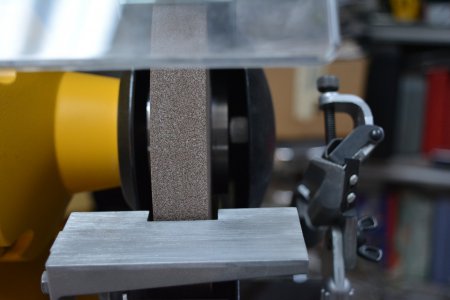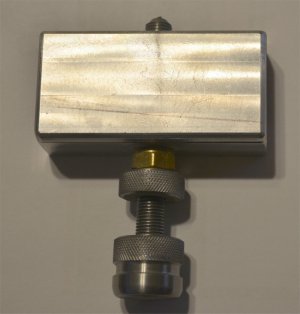- Joined
- May 27, 2016
- Messages
- 3,466
I had thought to put this in "Off Topic Discussions", but maybe some good will come of it here.
You know how it is - the not-so-expensive" 6" bench grinder with the reasonably quiet running 375W induction motor you can find in a DIY store on discount day. Clamp to a workmate and watch the whole kit starts to shimmy across the floor. Seems better when up to speed, but goes through a bit of a self-destruct shakeout through a resonance as it slows down.
Mine has always been like that, consigned to fitting on a pointy spiral to spin a buffing calico.
I decide to try again. The spiral pointy will not let go, even I remove it's grub screw altogether. No obvious way to get a grip. Eventually, it, and it's burr on the shaft, are removed. I set up an indicator to check the shaft, and it's perfect! Without wheels, it's absolutely sweet.
The two dished clamp rings, like oversized washers, one with the bigger hole.
What? Place together, and sight up the (slightly mangled) holes that don't seem to have the same centre. Hmm. is this some sort of "rotate one relative to the other" thing? Nah! It's a stamped out thing.
I put the green wheel on the right, because I dropped the left-hand thread nut down there, and I am gonna have to crawl to fish for it with the magnet rod
It runs out madly, but I find a "special spot" where if I keep clamping gently, and bumping it while I turn, I get it to the point I can nip it up not too tight. It won't tighten while holding on to the wheel. It turns the whole motor shaft. OK then. I settle for a short offcut of 15mm copper water pipe, split with hacksaw, and clamped with vise grips onto the motor shaft at the other end. Yay - it runs sweet. no mad vibrations! Trued up with a cheap diamond dresser that looks like the design owes something to the Gillette Razor Blade Company. It grinds on a flea market carbide too, just so nice!
So we get to putting on the other wheel. Left-hand M12 recovered, nothing can be done to get this one to run straight. It sways to left and right like a hula dancer!
Eventually, a "sort of" line up seems to happen, but cannot tighten up even a little without more bumping and washer clamp turning. Nearly there, but now no chance to get a grip on the shaft rotation. The inevitable happens. Grab the green wheel, and try to nip up the grey wheel anti-clockwise - and the nicely set up green wheel comes loose.
I will solve this - even if I have to turn up my own clamp washers, but dang! It shouldn't be this hard to put on a grinding wheel!
You know how it is - the not-so-expensive" 6" bench grinder with the reasonably quiet running 375W induction motor you can find in a DIY store on discount day. Clamp to a workmate and watch the whole kit starts to shimmy across the floor. Seems better when up to speed, but goes through a bit of a self-destruct shakeout through a resonance as it slows down.
Mine has always been like that, consigned to fitting on a pointy spiral to spin a buffing calico.
I decide to try again. The spiral pointy will not let go, even I remove it's grub screw altogether. No obvious way to get a grip. Eventually, it, and it's burr on the shaft, are removed. I set up an indicator to check the shaft, and it's perfect! Without wheels, it's absolutely sweet.
The two dished clamp rings, like oversized washers, one with the bigger hole.
What? Place together, and sight up the (slightly mangled) holes that don't seem to have the same centre. Hmm. is this some sort of "rotate one relative to the other" thing? Nah! It's a stamped out thing.
I put the green wheel on the right, because I dropped the left-hand thread nut down there, and I am gonna have to crawl to fish for it with the magnet rod
It runs out madly, but I find a "special spot" where if I keep clamping gently, and bumping it while I turn, I get it to the point I can nip it up not too tight. It won't tighten while holding on to the wheel. It turns the whole motor shaft. OK then. I settle for a short offcut of 15mm copper water pipe, split with hacksaw, and clamped with vise grips onto the motor shaft at the other end. Yay - it runs sweet. no mad vibrations! Trued up with a cheap diamond dresser that looks like the design owes something to the Gillette Razor Blade Company. It grinds on a flea market carbide too, just so nice!
So we get to putting on the other wheel. Left-hand M12 recovered, nothing can be done to get this one to run straight. It sways to left and right like a hula dancer!
Eventually, a "sort of" line up seems to happen, but cannot tighten up even a little without more bumping and washer clamp turning. Nearly there, but now no chance to get a grip on the shaft rotation. The inevitable happens. Grab the green wheel, and try to nip up the grey wheel anti-clockwise - and the nicely set up green wheel comes loose.
I will solve this - even if I have to turn up my own clamp washers, but dang! It shouldn't be this hard to put on a grinding wheel!
Last edited:


